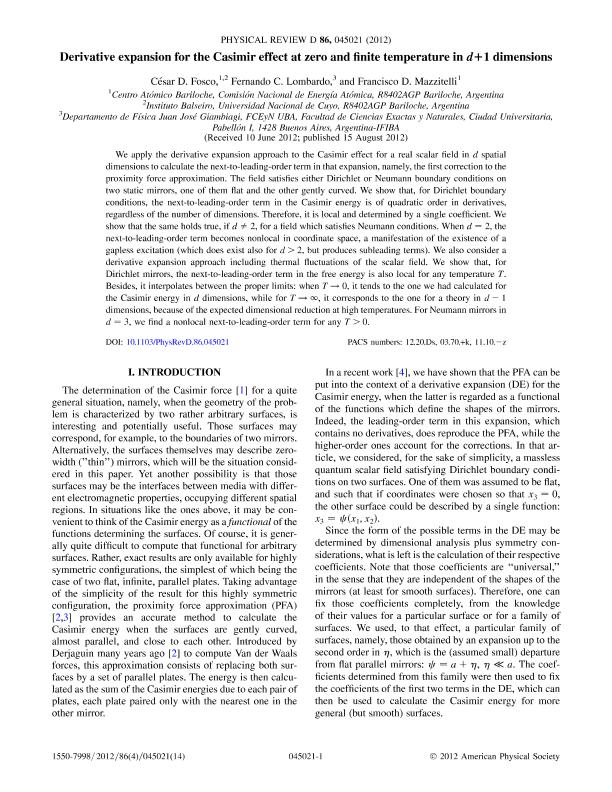Artículo
Derivative expansion for the Casimir effect at zero and finite temperature in d+1 dimensions
Fecha de publicación:
08/2012
Editorial:
American Physical Society
Revista:
Physical Review D: Particles, Fields, Gravitation and Cosmology
ISSN:
1550-7998
Idioma:
Inglés
Tipo de recurso:
Artículo publicado
Clasificación temática:
Resumen
We apply the derivative expansion approach to the Casimir effect for a real scalar field in d spatial dimensions to calculate the next-to-leading-order term in that expansion, namely, the first correction to the proximity force approximation. The field satisfies either Dirichlet or Neumann boundary conditions on two static mirrors, one of them flat and the other gently curved. We show that, for Dirichlet boundary conditions, the next-to-leading-order term in the Casimir energy is of quadratic order in derivatives, regardless of the number of dimensions. Therefore, it is local and determined by a single coefficient. We show that the same holds true, if d*2, for a field which satisfies Neumann conditions. When d=2, the next-to-leading-order term becomes nonlocal in coordinate space, a manifestation of the existence of a gapless excitation (which does exist also for d>2, but produces subleading terms). We also consider a derivative expansion approach including thermal fluctuations of the scalar field. We show that, for Dirichlet mirrors, the next-to-leading- order term in the free energy is also local for any temperature T. Besides, it interpolates between the proper limits: when T→0, it tends to the one we had calculated for the Casimir energy in d dimensions, while for T→∞, it corresponds to the one for a theory in d-1 dimensions, because of the expected dimensional reduction at high temperatures. For Neumann mirrors in d=3, we find a nonlocal next-to-leading-order term for any T>0. © 2012 American Physical Society.
Palabras clave:
Casimir
,
Proximity
,
Temperature
,
Approximation
Archivos asociados
Licencia
Identificadores
Colecciones
Articulos(IFIBA)
Articulos de INST.DE FISICA DE BUENOS AIRES
Articulos de INST.DE FISICA DE BUENOS AIRES
Citación
Fosco, Cesar Daniel; Lombardo, Fernando Cesar; Mazzitelli, Francisco Diego; Derivative expansion for the Casimir effect at zero and finite temperature in d+1 dimensions; American Physical Society; Physical Review D: Particles, Fields, Gravitation and Cosmology; 86; 4; 8-2012; 45021-45035
Compartir
Altmétricas




